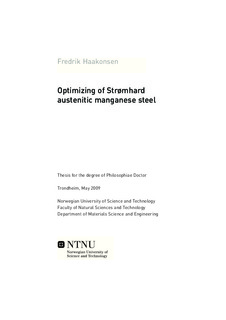| dc.contributor.author | Haakonsen, Fredrik | nb_NO |
| dc.date.accessioned | 2014-12-19T13:25:15Z | |
| dc.date.available | 2014-12-19T13:25:15Z | |
| dc.date.created | 2009-06-18 | nb_NO |
| dc.date.issued | 2009 | nb_NO |
| dc.identifier | 224456 | nb_NO |
| dc.identifier.isbn | 978-82-471-1554-1 (printed ver.) | nb_NO |
| dc.identifier.isbn | 978-82-471-1555-8 (electronic ver.) | nb_NO |
| dc.identifier.uri | http://hdl.handle.net/11250/248774 | |
| dc.description.abstract | In the present doctoral thesis the focus has been on two different ways to achieve improvement of the mechanical properties of an austenitic manganese steel. One of them was to introduce substrate particles and see if this could nucleate grains during solidification, giving grain refinement. The other one was to add a strong carbide forming element to the alloy, and affect the mechanical properties by precipitating carbides in the microstructure.
The base for the experiments was the steel Strømhard. Strømhard is a former patented steel produced by Scana Steel Stavanger AS. It is a modification of the Hadfield steels, and is used as a wear steel for typically handling and crushing rock and stone. As one of the main products of this company and with the expiration of the patent, an upgrade of this alloy was desired, to continue to be leading in this marked.
Cerium was chosen as the most likely grain refinement addition. As a highly reactive compound, cerium reacts with oxygen and sulfur already in the melt, forming cerium oxides and -sulfides which acts as substrate particles for melted steel to solidify on. Different amounts of additions, some times in combination with aluminum, were performed. Grain refinement was obtained in a casting added cerium in combination with aluminum, in which CeO2 was the supposed substrate particle.
To form carbides, vanadium was added in different amounts to form various alloys. Several heat treatments were carried out, to create a microstructure with increased resistance to abrasive wear, by precipitating carbides within the grains. Increased hardness with aging after austenitizing was detected, but most of these microstructures did not improve the wear resistance. Two heat treatment procedures seemed to give promising microstructures. One of these was the standard form of heat treatment for austenitic manganese steels, which left a portion of the vanadium carbides remaining in the microstructure, the other being the standard heat treatment followed by aging at 950 °C for 200 hours, giving evenly distributed carbides within the grains. However, neither of these treatments improved the wear properties. | nb_NO |
| dc.language | eng | nb_NO |
| dc.publisher | Norges teknisk-naturvitenskapelige universitet, Fakultet for naturvitenskap og teknologi, Institutt for materialteknologi | nb_NO |
| dc.relation.ispartofseries | Doktoravhandlinger ved NTNU, 1503-8181; 2009:88 | nb_NO |
| dc.title | Optimizing of Strømhard austenitic manganese steel | nb_NO |
| dc.type | Doctoral thesis | nb_NO |
| dc.contributor.department | Norges teknisk-naturvitenskapelige universitet, Fakultet for naturvitenskap og teknologi, Institutt for materialteknologi | nb_NO |
| dc.description.degree | PhD i materialteknologi | nb_NO |
| dc.description.degree | PhD in Materials Technology | en_GB |
